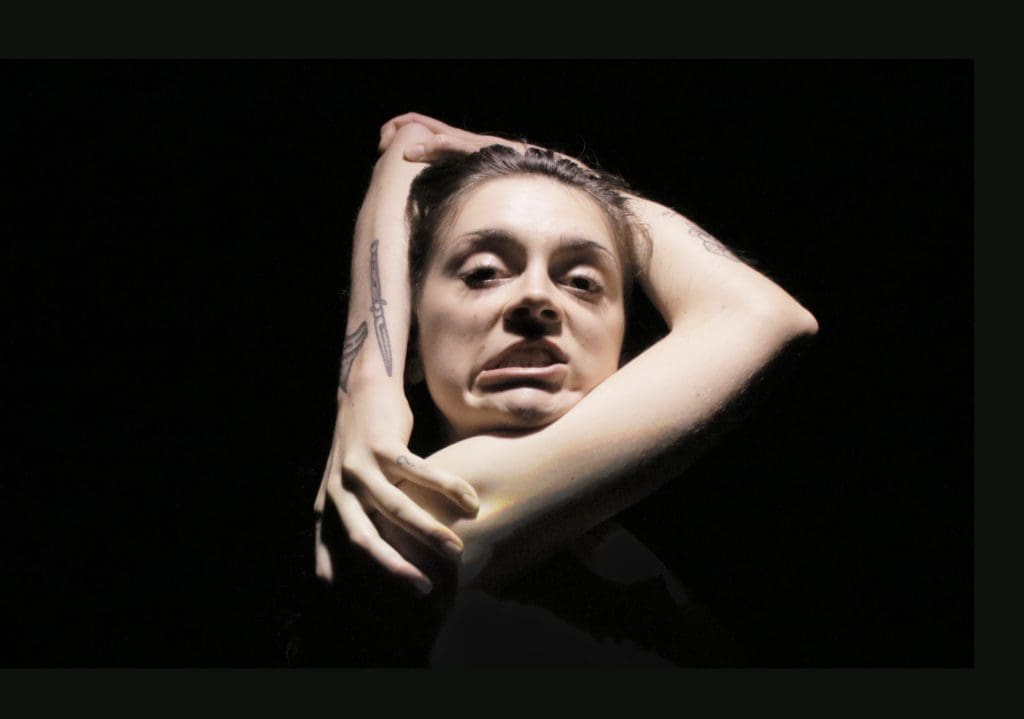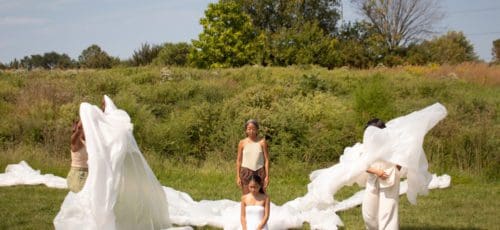Independent Artist Spotlight: Marina Cherry’s Only Bones v.1.6.
Edit: This event has passed.
—
With only herself, one light, and two square meters of space, Marina Cherry showcases her unique form of creativity by using movement to transport audiences into her personal reality.
Marina Cherry’s Only Bones v.1.6. is a performance in part of a greater concept, in which artists are tasked with creating a show in extremely minimalist conditions. As a concept, Only Bones strives to showcase artists in their most individual forms, returning physical theater and performance art to its most essential components. Cherry’s version of the show provides a quirky, thought-provoking, and at times unsettling look into her personality as an artist.
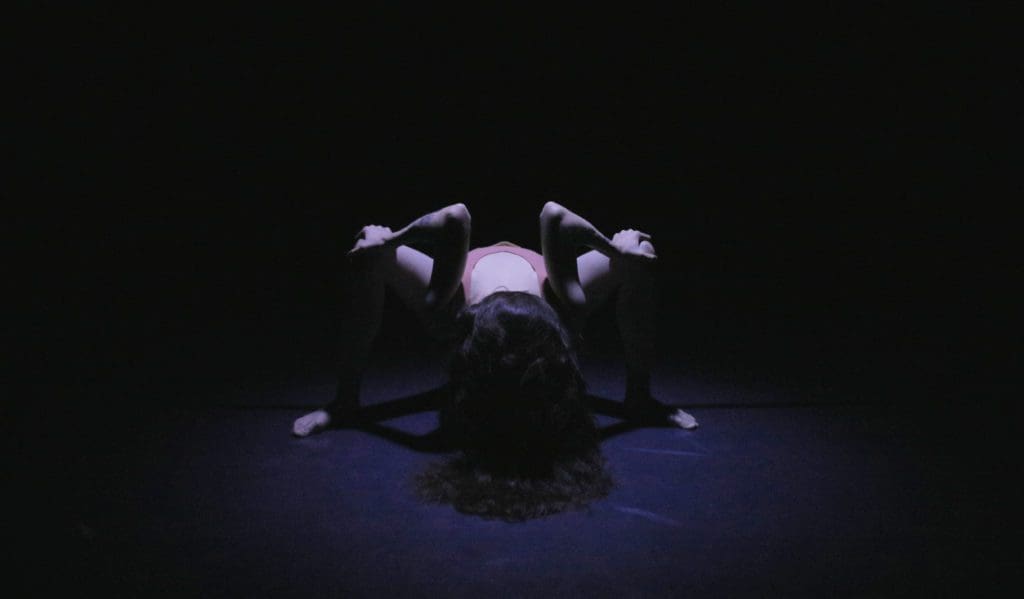
Image credit to Thomas Monckton.
Growing up in Missoula, Montana, Cherry quickly discovered the necessity of leaving in order to learn and discover herself as a circus performer and artist. Cherry began her career growing up as a gymnast and dancer, and soon found an affinity for the world of circus- a world which was not accessible from her hometown. Cherry reflects, “Not to discredit where I come from, because I’m very happy for my past, but I had always felt a bit of discomfort, kind of like a stranger in my own land… Circus-wise, art-wise, socially, the way that my lifestyle has settled, it’s a lot more accustomed to the European lifestyle”. At seventeen years old, after training for some time, she auditioned for an elite circus school in Montreal and got in, which she claims as being “somehow miraculous”. However, her talent was easily evident, as she then moved on to study at the circus school in Brussels, Belgium, finishing her degree in circus and performing arts. Since then she has been based primarily in Stockholm and Belgium, while also travelling for a variety of different projects across Europe. This launched her career as a performer, and led her to begin working on her first project, Only Bones v.1.6.
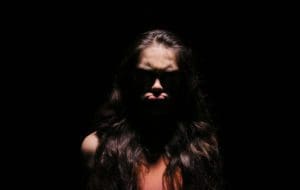
Image credit to Thomas Monkton.
Starting as a solo project in 2014 by creator and performer Thomas Monckton, Only Bones is a collection of solo performances done by various artists using a set of parameters originating from Monckton’s own piece. Using only one light, a small space, no text, no narrative, no props or objects, performers are challenged with creating a show solely through physical theater. “Stripping everything that’s extra, that’s why it’s called Only Bones- it’s really just the essentials of a show” explains Cherry. In the world of circus performance, which is typically identified with extravagance, Only Bones offers a refreshing, extreme minimalism that reveals a bare-bones story of the artist. Monckton, a physical theater artist himself, performed the first version of the concept, Only Bones v.1.0., then went on to pick artists who he felt would fit the concept to continue with their own versions. Cherry was introduced to Monckton in an audition for another one of his group projects, and her physicality and work with contortion and extreme flexibility led him to choose her as the sixth artist to participate in the concept of Only Bones. “It was something so different from the work that I had done in the past… As a dancer I see a big floor and I’m like, ‘okay, I want to take up all the space’. But no, basically you get to use two square meters, and I was really up for the challenge of that”. While Monckton assisted in terms of concept and execution, Cherry was able to solely work on the realization and intention of the piece, working very independently to create and perform Only Bones v.1.6..

Image credit to Frane Balta.
Foremost with her version, Cherry focuses on creating a piece that is an actualization of her thoughts rather than a definition of who she is. “In many ways I took it very lightly because I think the exploration of the self can get super heavy, and I just tried to pick a lot of different puzzle pieces to make something come together, but I wasn’t searching for anything complete of myself, or any specific explanation to anyone else but myself.” Things she encounters in the world, such as leaf blowers, helicopters, and moths looking for a light source, somehow mesh into a physical movement to paint a picture of her thought processes, abstracting from any explanations or necessity of them. By doing so she is able to play with different parts of her life or work, developing them into something different from what’s actually there. Motion is the key to her performance, as she uses the base of physical theater to achieve the essence of stage in her piece; “Making the concept into something physical, even if it doesn’t actually have anything to do with that. I think that’s part of the work of a physical theater artist. To make it not interpretive but to use your imagination in those very strange ways and to make it somehow inviting for other people to watch, so that it doesn’t seem too conceptual”. Abstraction is thus used to bring the audience into an experience of their own interpretation, with Cherry as the director of the process.
Stripped of all external factors and working entirely self-sufficiently, Cherry is pushed outside of her comfort zone in Only Bones v.1.6., and shares that vulnerability with audiences. “There’s no place to hide” states Cherry, “I would like people to look at it with an open eye, that it’s interdisciplinary. It would be very hard to label this as a circus show or dance show or a physical theater show… It’s different and it’s also very personal, but it’s very very bizarre and far removed from what a lot of people can physically perceive a body as being able to do. So to describe it to others it’s kind of just like, hold onto your seats for a second”. The bizarre is embraced by Cherry in her exploration of herself through this piece, as she describes her own work as often having a unique impact on audiences compared to other pieces of theater or dance. As a physical theater artist who fuses contortion and dance, Cherry uses Only Bones as an opportunity for her to explore larger themes, and how she can use her unique body movements to present them to an audience.
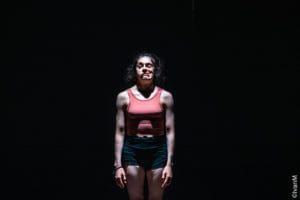
Image credit to Ivan M.
“I’m about to finish my philosophy degree on the side, not to label philosophy and connecting it to art, but I really enjoy the ‘big concepts’ of life and bringing that back to a more personal level. For example, contrasts or extremes and limits are big themes I work a lot with because my body can do many things that seem impossible. How to make that relatable is actually quite difficult… When people see a contortionist they’re often taken aback as not something that’s human, or something very weird and it makes them feel disgusted, or what emotions that evokes as well. I am very interested in human emotion, and how it touches people but also how, as a performer you’re very far removed from the public, and how to bring people in but realizing that you’re not actually connected to them, but you are bringing a very personal connection to a lot of people. That’s what stage does- it evokes feelings and emotions in other people, and also in yourself, and I think that’s a very special connection to be aware of… It’s real life and we all deserve to have these experiences”.

Image credit to Frane Balta.
Cherry also plays with societal perception through her work, using her choreography to make audiences question their preconceived notions of who she is, or what something can be. Towards the end of the piece, Cherry executes a series of movements that ‘transform’ her, from how she presents as a female to what she describes as an old man. “I transform into a very different type of person than I actually look like, and I really liked playing with that sort of physicality… questioning or provoking themes of social norms, of like, how do I look and what ideas would people get from me just as an image and how can I immediately change that or make people surprised by what’s beneath the surface”. In a jarring way, Cherry breaks down societal concepts through movement and choreography, questioning the limits of what something can be, and how it can be changed.
“I hope this performance would leave people with some sort of deeper questioning of themselves and the stories that they tell, and how it touches me as a performer, them as an individual, and us as a collective experiencing that show together”. Although Only Bones v.1.6. is created and performed in an extremely individual way, the interpretation and collective emotion of the audience throughout the piece is what makes this work profoundly intriguing. The piece can be experienced as a part of the 2021 Philadelphia Fringe Festival, September 9th through 15th at The MAAS Building Studio!
Article by Maria Dragone, Photojournalism Intern

